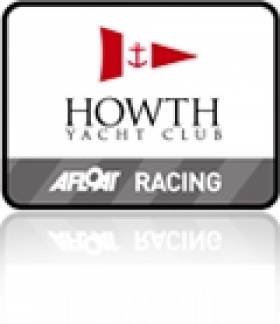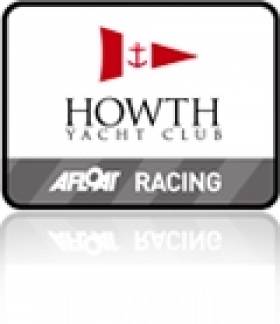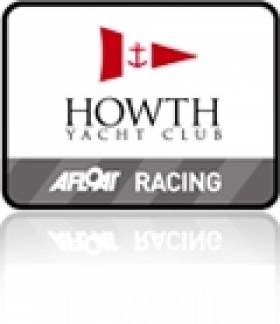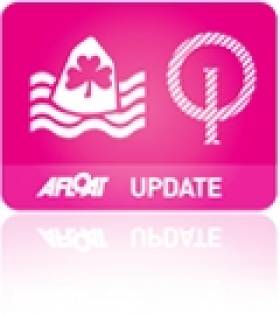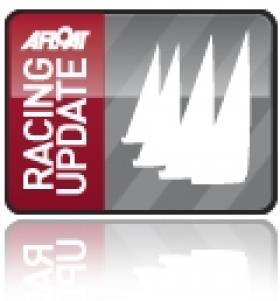Displaying items by tag: Howth Yacht Club
Healthy Turnout For Howth YC's Round Island Race
#HYC - Howth Yacht Club has a round-up of all the action from the Round Island Race on Saturday 15 March, with the wind's turbulence making for a tough day's sailing around Ireland's Eye.
But in spite of the poor weather forecast, a healthy total of 31 boats took part in the St Patrick's weekend event, including many Laser Radials and 4.7s - and all were challenged by conditions that varied from 17-knot breeze to strong gusts.
The HYC website has all the details and results HERE.
Cull Beats Craig for Laser Howth Honours
#hyc – Sailors were greeted with a stiff 12 to 15 knot Southerly, as the sun slowly but surely managed to break through the clouds in what proved an eventful last day of Howth Yacht Club's laser series on Sunday.
Two races were sailed back to back, with the tide dictating the tactics on the start line and subsequent beats. Despite the busy Committe boat end the fleet had a clean start as most of the sailors tacked early out to the right. For those who fancied their luck on the left side of the course could only watch as the Starboard tackers crossed in front by a country mile. Conor Murphy of Malahide, fresh from his win at the IUSA Intervarsities,led this race from start to finish in what was a deserving win, despite the efforts of Paul McMahon who was in hot pursuit!
The strong flood tide reassured sailors that there was only one way to sail the beat, and that was to head for the Starboard layline. Again, the fleet got away cleanly and most tacked immediately out to the right. Ronan Cull led from Sean Craig at the WW mark and the two managed to hold their positions to the end.
The overall standings for the Standard Rig: 1st Place - Ronan Cull; 2nd Place - Sean Craig; 3rd Place - Colm Cunningham
In the Radial, Aoife Hopkins took first prize to round off a successful Winter season.
Next week will officially conclude proceedings with the Annual Round the Island race, and here at Howth we're hoping for a great turnout once again from near and far.
This year will also see the RS 400 fleet join in on the fun, so hopefully the weather holds out!"
#hyc– A more civilised wind forecast greeted the Howth Frostbite sailors last Sunday, with a Fresh SSE at 15knots made for an enjoyable two races in the rain. The Race Committee (RC) ran two great Olympic course races for the 16 sailors who made it to the start line.
Race 1 saw an early start with most of the fleet over the line due to the turning ebb tide.
After a General Recall, the fleet got away successfully with a Committee boat favoured start line. Those who started near the RC boat were able to climb over those further down the line in a lifting gust out to the Port lay line. Racing was tight up the first beat on this occasion with the top five boats rounding within seconds of each other at the top mark.
A tricky cross swell on the run made for a few capsizes and those who stayed in the gusts on the left side of the downwind run made significant gains. Paul McMahon took line honours after fending off several chasing sailors.
Race two got underway with a Port favoured line with the leaders coming off the pin sailing to the left side of the course. Paul McMahon, once again took the initiative by putting some good distance between himself and the chasing pack on the reaches.
The Final race day of the series is next Sunday so we're hoping for a big turnout!
Howth Yacht Club Laser Sailors Get the Better of Sunday's Storms
#hyc – Although the general forecast was for meteorological mayhem throughout Ireland on Sunday, Howth Yacht Club's Laser Frostbite Race Officer Liam Dineen reckoned that an expected but brief mid-morning patch of softer winds, coupled with the fact that it was low water to maximise shelter in the Sound inside Ireland's Eye, provided a small window of opportunity for some much-needed sport.
Admittedly, of the 43 regular entries in the Howth winter series (which has been a hardy annual since 1974), only eleven came to the line to challenge a shifty southerly which was 21 knots gusting 26, though it felt much stronger owing to the exceptional density of the mid-February air.
In fact, at one stage the breeze was recording as low as 16 knots. But most of the time it was a morning for screaming reaches, hairy gybes, and a couple of spectacular capsizes. At the front of the fleet, veteran Lasermen Mike Evans and Stephen Quinn had a head to head throughout the one race sailed before conditions closed down again, and at the finish it was Quinn in the lead with Evans still hounding him.
All agreed that with the weather we've had this winter, an hour of superb sailing in February sets you up every bit as well as a whole day of sunshine sport in high summer. The Howth fleet are looking forward to their final two weekends with this popular series, which attracts Laser frostbite enthusiasts from all along the east coast of Ireland.
They're anticipating a big turnout for their traditional concluding race round Ireland's Eye on Saturday March 15th, a highlight of the St Patrick's Weekend. It's an open event, and not restricted solely to those who have completed the Frostbite Series. The entry fee includes the legendary Laser Lunch which morphs seamlessly into the afternoon's rugby match. Details later this week on hyc.ie
Howth's Sailing Story to Finance Fiddles
#hyc – By popular demand, Afloat.ie blogger W. M. "Winkie" Nixon's light-hearted take on "The Story of Howth Sailing" is having a new performance with an enhanced version which now includes historic sailing film material.
It's scheduled for next Wednesday, February 26th, at 7.30pm, and this time it's in Howth Yacht Club. All are welcome, and admission is €15 as all proceeds are going to the St Agnes Youth Orchestra funding programme run by Jimmy Kinahan of Poolbeg Y & BC.
Irish Optimist Youth Sailing Season Already Underway
#optimist – Yesterday Optimist sailors in Cork and Dublin were packing a punch into training in Cork and Dublin writes Claire Bateman. Royal Cork YC members of the Irish Optimist Squad were training at Howth Yacht Club and other RCYC squad members were training in Cork Harbour where they presented a spectacular sight as they appeared to be literally flying up and down and around in a stiff W/SW bitingly cold breeze in the immediate vicinity of the club.
Next week Optimist training will move to Baltimore for the mid term schools break and sailors will spend the full week undergoing rigorous coaching and workouts. It also provides the opportunity for a mid term family break for other members of the families as they generally move to Baltimore for the week.
This is an extremely important year for the Optimist Class as the European Championships 2014 will take place in Dublin. A decision has been taken not to compete in the World Optimist Championships 2014 but to concentrate wholly on the European Championships. Obviously the venue is very accessible for the Irish sailors and will give some extra competitors the chance to participate where they might not have been able to access the Worlds at some far lung venue.
The Royal St. George Club will host the Europeans from July 12th to 20th, 2014 and credit for securing the event for the country must be given to Frank O'Beirne of RStGYC. This means that Ireland as the host nation will have fourteen places instead of the usual seven.
Following the Worlds, Optimist action will move on to the CH Marine Irish Optimist Nationals and Open Championship to be hosted by the Royal Cork Yacht Club from August 14th to 17th, 2014.
Strong Winds Make Irish Moth Sailors Fly at Howth Yacht Club
#moth – Maybe it's the fun factor, maybe its the fear factor – Graeme Grant braved the strong winds off Howth today to sail his Moth foiling dinghy on the first day of the inaugural Moth Irish Championships.
Capable of sailing at over 30 knots, Grant demonstrates the foiling dinghy (pictured above) that has captured the imagination of a number of Irish dinghy sailors and led to this weekend's first gathering of hydrofoil sailors in Ireland.
Four International Moths are sailing from Dun Laoghaire on a regular basis. Dun Laoghaire boats usually take part in the DBSC summer series PY racing along side a growing fleet of 49ers. The number includes Laser European Champion Annalise Murphy.
One Fastacraft Zero sails from Blessington Sailing Club, in County Kildare. Blessington offers a great place to learn to sail Moths in flat lake water with the safety of the shore never too far away.
One Ninja based in Howth is sailed by Graeme Grant.
Built almost entirely out of carbon fibre, the International Moth is the most technically advanced racing dinghy in the world. With an all up weight of around 30 kilograms, the boat is designed and built to fly.
The International development sailing class has a history of 75 years of continuous innovation.
Howth Hosts Moths For 2013 Irish Open Next Weekend
#Moths - If you enjoyed all the action of the America’s Cup recently, you'll be sure to love watching the Moths racing in Howth for the 2013 Irish Open next weekend.
Howth Yacht Club will play host to the event on 2-3 November for the international Moths, foiling single-handed boats that are very fast and incredibly exciting to sail - and to watch!
Spectator boats will be available on both days of the event, and the organisers will do their best to facilitate anyone interested in being on board - contact Laura Dillon at [email protected] indicating which day you would prefer to watch.
Organisers are also hoping to have some video footage playing in the bar on Saturday evening after the day's racing, and all are welcome to attend.
In addition, organisers are looking for a number of yachts, motor boats and RIBs to take some spectators out - anyone willing to volunteer should contact Laura Dillon via the email address above as soon as possible.
SB20 Champ Lifts All Ireland Title in Single Day Championship off Howth
#allirelandsailing – Racing under the shadwo of a gale warning SB20 champion Ben Duncan has been crowned All Ireland Sailing Champion after a single day seven race regatta in changeable conditions at Howth Yacht Club this afternoon. Full results downloadable below as a jpeg file. Second was junior champion Seafra Guilfoyle. Flying fifteen champion Ian Mathews was third.
The day began with the 16 class representatives and their crew being split in to two eight boat fleets. Due to the forecast weather conditions for Sunday, the decision was made to sail two races in each fleet in the morning with the top four teams from each progressing to the Final Series which would take place in the afternoon. Sailing in the Irish Sailing Association's J80 keelboats, the first eight teams took to the water for a 10.30am start in a 15 knot south-westerly.
Leading the fleet in the first race was SB20 champion Ben Duncan who took the bullet followed byMatthews from the National Yacht Club in Dun Laoghaire and John McGuinness from Moville in Donegal. It was local Howth Yacht Club sailor Cillian Dickson who took the win in the second race followed by Ben Duncan with Ian Matthews in third.
On a total of 3 points, Ben Duncan and crew Joe Turner and Davie Taylor were the overall winners of the first fleet earning their place in the afternoon's Final Series. Also progressing to the Final were Ian Matthews (5 points), Cillian Dickson (6 points) and John McGuinness (8 points).
Facilitated by an on-the-water changeover, the second eight teams began racing almost immediately as strong winds were forecast for the early afternoon. Fireball sailor Noel Butler took the first win followed by a third in the second race, securing his place in the final. Also moving forward was Colin Byrne from Dun Laoghaire with two second place finishes and tied on 4 points with Noel Butler. Finishing third overall in the fleet on 5 points was teenager Séafra Guilfoyle who was invited to the championships upon winning the Junior event last month in Cork. And the sailor taking the last place in the Final Series was Trevor Kirkpatrick from Carrickfergus with a total of 8 points.
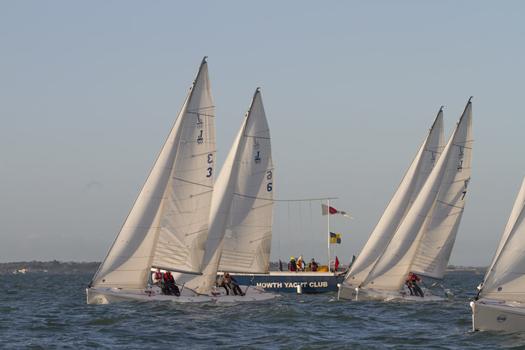
J80 fleet start during the ISA senior all Ireland championship 2013 hosted by Howth yacht club Dublin
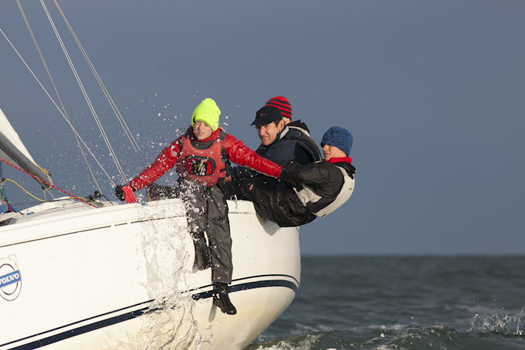
Seafra Gulfoyle from the Royal Cork Yacht Club with crew members Dylan O'Grady Patrick Crosbie Nick Walsh won the final race of the ISA All Ireland sailing championships and secured 2nd overal for the event which was hosted by Howth yacht club in Dublin.Crew member Dylan O'Grady (nearest) was the youngest competitor at just 11 years of age.
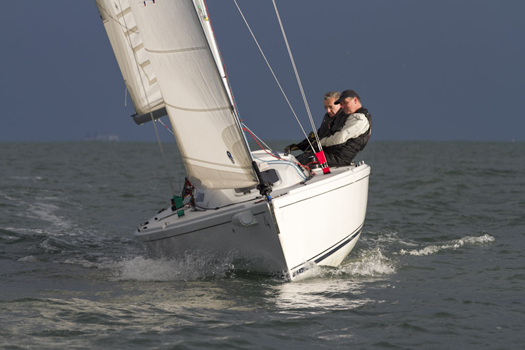
Ian Matthews of the National yacht club Dun Laoghaire crewed by Keith Poole and Nial Meagher finished third overall in the ISA Irish senior all Ireland championships hosted by Howth Yacht Club Dublin.
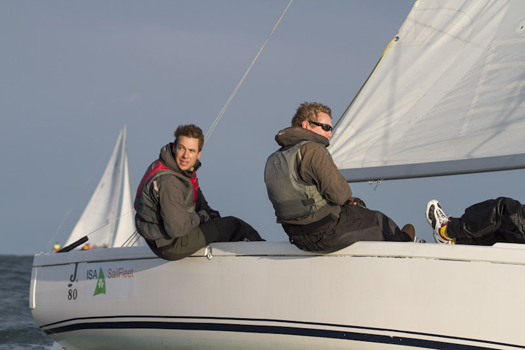
Overall winner of the Irish senior all Ireland championship Ben Duncan his crew Joe Turner/Davie Taylor work hard upwind during the event hosted by Howth yacht club Dublin.

J80's sailing close to Ireland eye during the ISA senior all Ireland championship 2013 hosted by Howth yacht club Dublin.
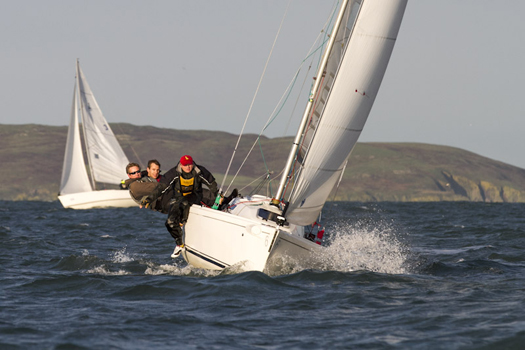
Ben Duncan ISA Irish senior all Ireland champion 2013
All sailors returned to the shore after the fleet racing had finished as the wind had picked up to almost 30 knots. After a two hour break and the boat draw racing resumed at 3.55pm. Three final races were successfully completed in 8 knots but after the second race Ben Duncan had the championship in the bag. He went on to win two of the three races and placed second in the other winning the event on a total of 5 points with a four point lead. In second place was young Séafra Guilfoyle who won the last race of the regatta and finished on a total of 9 points. Séafra also had the youngest crew member of the event on his team, Dylan O'Grady who is only 11 years old. Bronze went to Ian Matthews who finished on 12 points.
All Ireland Sailing Line-Up Announced for Howth Event
#allirelandsailing – Prior commitments mean the All Ireland sailing champion Peter O’Leary will be unable to defend his 2012 title. Nor will any of his Olympic 2012 team mates make the Howth Yacht Club start line as Annalise Murphy, Ryan Seaton and Ger Owens, who all received nominations, bow out of tomorrow's competition, where big breeze is expected. The ISA released the line up of 16 competitors this morning. Download line up below as a jpeg file.
As Afloat.ie reported earlier the ISA initially planned a prequalification round for the event for tomorrow but these plans appear to have changed, giving an appearance that 16 is all that could be mustered, a far cry from a few years ago when there were complaints over not getting invited, even to the prequalifying Friday line-up of 28 plus classes.
The 16 class representatives hail from all four corners of the country; nine sail from Dublin, three from Cork and one a piece in Westmeath, Limerick, Donegal and Antrim.
Mermaid – Mark Boylan, Skerries SC; Fireball – Noel Butler; ICRA '1' – Colin Byrne, Royal Irish YC; Laser Radial – Thomas Chaix, Kinsale YC; J24 – Cillian Dickson, Howth YC; SB20 – Ben Duncan; Junior Winner – Séafra Guilfoyle, Royal Cork YC; Shannon OD – Laurence Hanley, Lough Ree YC; Ruffian – Trevor Kirkpatrick, Carrickfergus SC; Wild Card – Finn Lynch, National YC; Flying Fifteen – Ian Mathews, National YC; ICRA '2'– Simon McGibney, Foynes YC GP14 – John McGuinness, Moville BC; RS400 – Emmet Ryan, Royal St George YC; Multihull – Mark Small, Kinsale YC; Howth 17, Mike Toomey, Howth YC.
Among them is a strong up-and-coming youth contingent. Finn Lynch from the ISA Academy earned a wild card nomination for his recent performance at the Laser European & World Championships. The 17 year old took home three medals at the regatta including Gold - U21 Men’s Laser Radial Worlds, Silver – Men’s Laser Radial Europeans and Bronze – Men’s Laser Radial Worlds. Joining Finn in the line-up will be fellow Academy member Séafra Guilfoyle who earned his place by winning the Junior All Ireland event last month in Co. Cork.
Representing the Mermaid class will be Mark Boylan who this year became the youngest ever Mermaid National Champion at the age of 20. And making up an all youth crew for Optimist Squad coach Thomas Chaix will be Dara O’Shea and Douglas Elmes who have since graduated from Oppies and Johnny Durcan who is still on the national Optimist Squad.
The 16 boats will compete in two fleets of eight on Saturday, each scheduled for three races. From there the top three boats from each fleet will progress to Sunday’s final four-race series with two places remaining for the top two boats from a two-race repechage on Sunday morning.
Up to 25 knot south westerly winds are forecast for both days of competition.


























